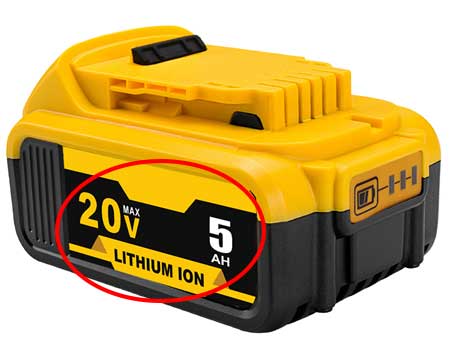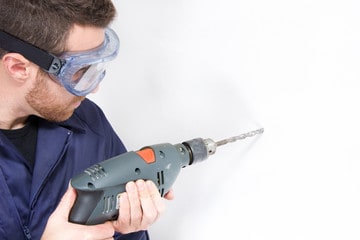The power of a drill battery is the amount of energy it can deliver to the drill at a given time. The drill battery power is measured by the watt (W). It is a multiplication of voltage (V) and ampers (Ah). Drill batteries are available as different voltages such as 12V,18V and 20V and have different capacities 1.5Ah to 12Ah. These drill batteries have different ranges of power that can be used for a wide range of purposes.
The maximum power of the drill is higher than the drill battery. This occurs due to starting voltage and current. A drill battery charger consumes 30-60 watts during a drill battery is charging. A drill battery’s power can be lost due to not fully charging and discharging the battery, storing in extreme temperature areas, overusing the battery, charging with the wrong charger, physical damage, improper maintenance and improper storage. You can save the drill battery by using a proper angle drill bit, using a hammer drill, using an impact mechanism, using high RPM for soft materials and low RPM for hard materials.

What is the Power of a Battery?
The power of a battery is the rate at which it can convert stored chemical energy into electricity. It is measured in watts (W) and calculated by multiplying the battery’s voltage (V) by its current (A). The formula of Power (P) = Voltage (V) x Current (A). This power rating influences how quickly a battery can deliver energy to a device or system. The higher the power rating, the more electrical energy a battery can provide at a given time.
What is the Power of Drill Battery?
The power of a drill battery is the amount of energy it can deliver to the drill at a given time. The drill battery power is measured by the watt (W). It can be calculated by the multiplication of voltage (V) and ampers (Ah). Drill batteries are available as various voltages and ampers in order to supply various watts to the drilling machines.
What is the Voltage in the Drill Battery?
The voltage of the drill battery is the electrical potential difference between the positive and negative terminals. Drill batteries are available as different voltages, including 12V,18V and 20V. For the extreme heavy duty task we can use 36V, 48V and 60V batteries. When the drill battery voltage goes high, it tend to increase the more torque in the drilling machine.
What is the Amperes (Ah) in the Drill Battery?
Ampere-hours (Ah) in a drill battery is the battery’s capacity. “AH” indicates how much electric charge a battery can deliver over time. Drill batteries usually have an Ah rating between 1.5Ah to 12Ah, with the higher value implying a longer-lasting battery. Amperes rating gives an idea of how long the battery can last before it needs to be recharged.
How to Calculate the Watt in Drill Battery?
The power of the drill battery can be calculated by multiplying voltage and ampers (VA). The calculated power is measured by the “Watt-hours”.

Dewlat DCF894B is powered by with 20V and 5Ah battery.
What is the watt hour of the battery?
Watt-Hours = Voltage * Amh = 20V * 5 Ah = 100 Watt-hour.
How many Watts in the Drill Battery?

Most of drill batteries are available as 12V,18V, and 20V. Those batteries consists of 1.5Ah – 5.0Ah capacity. When you use these drill batteries, you can have the maximum watt that is mentioned below.
| Battery Voltage | 1.5 Ah | 2.0 Ah | 3.0 Ah | 4.0 Ah | 5.0 Ah |
| 12V | 18 Wh | 24 Wh | 36 Wh | 48 Wh | 60 Wh |
| 18V | 27 Wh | 36 Wh | 54 Wh | 72 Wh | 90 Wh |
| 20V | 30 Wh | 40 Wh | 60 Wh | 80 Wh | 100 Wh |
Why Maximum Power of the Drill is Greater Than Drill Battery Power?
When you buy a cordless drill or driver, you can see there is a maximum power value. It will tell you if the tool is operated with its maximum power, it will consume that much power. Normally none is operated with the maximum. It will be mostly less than 60%.
Normally most drills are with 500 to 1000 watts required for maximum power. If the tool is operated with its maximum power, it will need a large number of watts. If the tool is operated like this, it will definitely be overheated. So don’t care about the high watts requirement of the tools. We are not able to provide a large number of watts for the maximum power using the battery.
How many Watts are Consumed by the Drill Battery Charger?
The amount of watts a drill battery charger consumes can vary depending on the specific model of the charger and the battery it’s charging. A typical charger for a cordless drill might consume between 30 to 60 watts. However, this can vary widely, and the best source for this information would be the user manual or technical specifications provided by the manufacturer.
How to Loose the Power of Drill Battery?
The drill battery power can be lost due to below 10 reasons. Power loss causes to die the drill battery soon. In order to prevent damage and improve the durability of the drill battery, you should avoid these things.
- Not fully charging and discharging the battery.
- Storing the battery in extreme hot or cold temperatures.
- Overusing the battery without giving it a rest.
- Frequently using the battery on high-power tasks.
- Not using the battery for an extended period.
- Charging it with a mismatched charger.
- Dropping or physically damaging the battery.
- Overcharging the battery for an extended time.
- Not maintaining the battery cleanliness, especially the terminals.
- Improper storage, particularly in humid or wet places.
How to Save the Drill Battery Power
You can save the drill battery power by using proper drill bits, drill bit angle, drilling mechanisms, and drilling machines. Additionally, you can save power using the drill in proper environmental conditions because high heat helps to discharge the drill batteries rapidly.
- Use the proper angle drill bits with suitable mechanisms
- Use hammer drill mechanism for brick, stones and concrete
- Use an impact mechanism for driving screws
- Use High RPM for soft materials such as wood, aluminium
- Use low RPM for hard materials such as metals, tiles etc.
- Use proper drill bits for specific materials.

